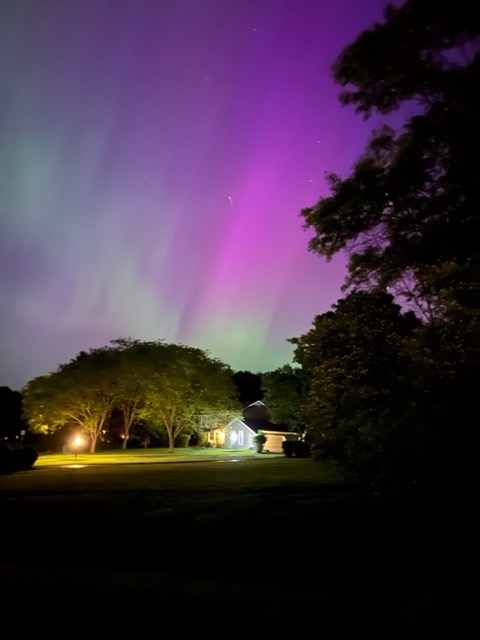Who would’ve guessed? Viewing the Aurora Borealis close on the heels of experiencing a total solar eclipse, both from Ohio! Not me. I read about the possibility of seeing the Northern Lights much further south than usual and looked forward to the event. But the evening arrived, and after a busy day of running errands, I had forgotten. I settled into my recliner ready for a quiet evening when an urgent shout broke into my reverie:
“Jordan! Jordan!” my neighbor yelled to his friend in the apartment above mine.
An emergency? Someone’s hurt? My phone rang: “Mary, get out here! You can see them!”
Thank goodness for my neighbors. In minutes, six of us lined up in my driveway. Chairs for everyone, but mostly we stood. I put on water for tea (It was chilly.) and called my sister and her husband.
The aurora had arrived, even in the city, and joined a bright crescent moon, planets, and stars in the clear night sky. Despite streetlamps and security lights, swaths of purple, pink, and green danced over apartments and trees.
“Look through your phone,” someone called out, and I remembered an interesting fact from articles giving instructions on when and how to watch. Auroras are the result of streams of charged particles ejected from magnetic storms on the sun and propelled into space. Some reach earth and glow with colored light when they collide with oxygen and nitrogen atoms as they speed into our upper atmosphere. The rare strength of the solar storms the days before and force with which the large the particle streams were expelled from the sun pushed the aurora south. As amazing as the human eye is, the lenses in cell phones are much better at collecting light, including that emitted by the glowing particles.
Pale purplish pink hues became stunning magenta when viewed through the phones. Greens popped from soft to brilliant. So, there we stood, looking with our eyes then marveling at the sight through our phone lenses. This solar system, our home, has been e What else awaits discovery?
What else – on our planet, in the universe – emanates beauty simply by being? What windows into truth and mystery surround us? And how can we see them? What lenses might we need? I wondered about this for a few days, and the question came along as I walked along the Scioto River and saw a blue heron, tall and majestic. There he was, a pillar of peace and stillness with mallards fussing and flitting about, chasing one another away with loud honks and flapping wings that splashed in the water. The heron remained focused, and one slow, purposeful step at a time, moved through the water without disturbing its surface.
How did he see his watery world, I wondered. And what about lenses of other creatures and the ones that enhance (or cloud) my own vision?
Sometimes I use a jeweler’s loupe to examine ordinary objects. Sometimes I use lenses on my stereomicroscope to look extremely closely and discover complexity, pattern, and design of ordinary objects invisible to the naked eye.
With the help of the Hubble and James Webb Space Telescopes we can look deeply into the universe and back in time to its beginnings. We see stars being born and galaxies speeding away from one another.
But lenses don’t always make things clearer. They can alter or obscure. Our perception can be distorted when we look with eyes, hearts, and minds clouded by prejudices, fear, and anger. Have you ever shared an experience with others and come away shaking your head when various accounts of what happened are at opposite ends of the spectrum? (Think, January 6.) Different lenes.
How, I wondered, can I “clean my lenses” and be aware of everyday wonders of creation? They needn’t be auroras or solar eclipses to inspire and enchant, revealing the Sacred simply by being. To see divinity dwelling not only in nature and creation around me but also within my own heart? To see that the Incarnation did not start with Jesus of Nazareth, but with the Big Bang—everything infused with the Spirit of the Source.
Seeing through the lens of Grace can be a challenge. A line from the play “Our Town” comes to mind. “Who,” wonders Emily while revisiting a day in her life after she had died, “who realizes the beauty and wonder of ordinary life as it is lived, moment by moment.” The stage manager answers, “The saints and poets, maybe they do some.”
How to develop such an eye? “Be present to the moment,” I think, “wide-eyed and open-hearted.” Nurture curiosity. Befriend quiet and get in touch with one’s deepest center. Cultivate the practices of wonder and awe. Look closely, beyond what we see at first glance – including people as well as the rest of creation. And discover what clouds our vision and do what we can to wipe them from the heart.
What a gift the spectacular cosmic displays have been, reminders of the Glory that surrounds us if we have the eyes and heart to see.





Such a lovely writing Mary.. I love herons! They really are so still until they sense you are near, then the depart! Only to land again after securing more private space. I think Cormorants are similar in their focus and privacy from man/woman preferences. Thanks for sharing the gorgeous photos! I didn’t see the Aurora Borealis though I was visiting Oberlin, OH from VA and stepped outside at about 3:00 am. So cool that you had that experience and are sharing it! 💜
Thank you for writing, Liza. Sorry you missed the Aurora but glad you enjoyed the column and photos.The weather really was beautiful. Yes, Heron’s are beautiful and majestic. I saw another today in the river’s inlet and stood a long while watching it. Such a gift!